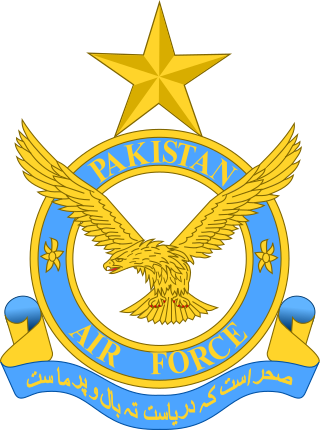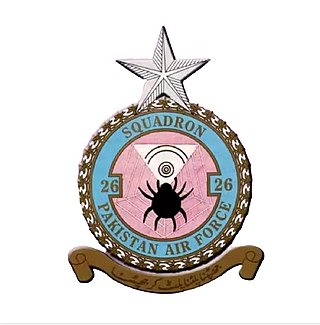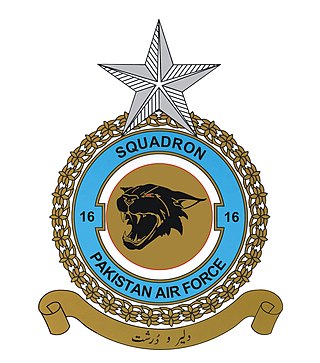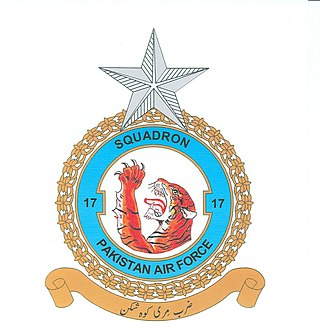
The Pakistan Air Force (PAF) is the aerial warfare branch of the Pakistan Armed Forces, tasked primarily with the aerial defence of Pakistan, with a secondary role of providing air support to the Pakistan Army and Pakistan Navy when required, and a tertiary role of providing strategic airlift capability to Pakistan. As of 2024, as per the International Institute for Strategic Studies, the PAF has more than 70,000 active-duty personnel. PAF stands as the eight largest Air Force in the world. PAF is the largest Air Force of the Muslim world in terms of aircraft fleet. Its primary mandate and mission is "to provide, in synergy with other inter-services, the most efficient, assured and cost effective aerial defence of Pakistan." Since its establishment in 1947, the PAF has been involved in various combat operations, providing aerial support to the operations and relief efforts of the Pakistani military. Under Article 243, the Constitution of Pakistan appoints the President of Pakistan as the civilian Commander-in-Chief of the Pakistan Armed Forces. The Chief of the Air Staff (CAS), by statute a four-star air officer, is appointed by the President with the consultation and confirmation needed from the Prime Minister of Pakistan.
The Pakistan Air Force Academy Asghar Khan is an accredited four-year military academy which provides undergraduate education to officer candidates for the Pakistan Air Force.

Pakistan Air Force Base, Nur Khan is an active Pakistan Air Force airbase located in Chaklala, Rawalpindi, Punjab province, Pakistan. The former Benazir Bhutto International Airport forms part of this airbase. PAF College, Chaklala, a well nurturing institute for Aviation Cadets of the college is also located in the base. Fazaia Inter College Nur Khan is also located in the base.
Tanvir Mahmood AhmedNI(M) HI(M) SI(M) SBt is a retired air chief of the Pakistan Air Force who was the Chief of the Air Staff from 2006 to 2009. He was succeeded by Rao Qamar Suleman on 18 March 2009.

During the Indo-Pakistani war of 1965, the Indian and Pakistani Air Forces engaged in large-scale aerial combat for the first time. In the air war, which took place in September, both air forces conducted thousands of defensive and offensive sorties over Indian and Pakistani airspace. Both India and Pakistan claimed victory in the air war; Pakistan claimed to have destroyed 104 Indian aircraft and lost 19, and India claimed to have destroyed 73 Pakistani aircraft and lost 35 of its own. The air war ended in a stalemate.
Rao Qamar SulemanNI(M) HI(M) SI(M) SBt TI(M) LoM was the 12th Chief of Air Staff of the Pakistan Air Force. The four-star ranked general commanded the PAF from 2009 to 2012. Earlier, Suleman served as Deputy Chief of Air Staff of Operations. He was succeeded by Air Chief Marshal Tahir Rafique Butt as Chief of Air Staff on 7 March 2012.

No. 9 Squadron, named the Griffins, is a Pakistan Air Force fighter squadron assigned to the No. 38 Multi-Role Wing of the PAF Central Air Command. The squadron is stationed at PAF Base Mushaf, Sargodha. It was the PAF's first fighter squadron and has been commanded by seven Chiefs of Air Staff of the Pakistan Air Force. The squadron crest is a red griffin which symbolises strength, aggressiveness, and vigilance. Scrolls around the squadron crest display the battle honours Sargodha 65 and Karachi 71.The Griffins are considered as the PAF's most elite unit as well as its most senior.
The history of the Pakistan Air Force (PAF) began when it was established in 1947 following the independence of Pakistan.

The No. 24 Electronic Warfare Squadron, nicknamed the Blinders, is an electronic warfare unit of the Pakistan Air Force equipped with DA 20EW Faclons. It is the PAF's only Electronic Warfare squadron and undertakes EW, ECM and ESM missions while also training Pilots, Air Defense controllers and engineering officers in EW environments.

No. 7 Squadron, nicknamed the Bandits, is a tactical attack squadron of the Pakistan Air Force. Which is under the No. 38 Tactical Attack wing.

The No. 26 Squadron, nicknamed the Black Spiders, is a multi-role squadron of the Pakistan Air Force's Northern Air Command. It is currently based at Peshawar Airbase and operates the PAC JF-17 Thunder multirole fighter jets.

No. 16 Squadron, nicknamed the Black Panthers, is a multi-role squadron of the Pakistan Air Force's Northern Air Command. It is currently based at Minhas Airbase and operates the PAC JF-17 Thunder multi-role jets.

The Pakistan Air Force Strategic Command is one of the major regional formations of the Pakistan Air Force headquartered at the Air HQ in Islamabad.
Military exercises are conducted by the Pakistan Armed Forces to increase combat readiness, and to identify problems in logistics, training, and current military doctrine. They also test the ability of units to work together. Lastly, they act as a visible expression of military might, which acts as a deterrent to potential enemy action. An important component of each exercise is the after-action assessment. Since 1989 the four branches services have increasingly begun coordinated exercises.

The Combat Commanders' School or CCS is the advanced air combat tactics development and training school of the Pakistan Air Force (PAF) based at PAF Base Mushaf, Sargodha, Pakistan.

No. 8 Squadron, nicknamed the Haiders, is a tactical attack squadron from the No. 32 TA Wing of the Pakistan Air Force's Southern Air Command. It is currently deployed at Masroor Airbase and operates the JF-17A Multi-role fighter.

The No. 23 Squadron, nicknamed Talons, is an air superiority fighter squadron of the Pakistan Air Force. It is based at PAF Base Samungli in the Balochistan province of Pakistan and operates the Chengdu F-7PG aircraft.

The No. 17 Squadron nicknamed Tigers, is an air superiority squadron of the Pakistan Air Force's Northern Air Command. It is currently deployed at Peshawar Air Base and operates the Chengdu F-7PG aircraft.

Air Vice Marshal Abdul Razzaq Anjum SI(M) TI(M) Sbt was a two-star rank officer of the Pakistan Air Force who held the position of Deputy Chief of the Air Staff. He died in an air crash, along with CAS of the PAF Mushaf Ali Mir, his wife Begum Bilquis Mir, Air Vice Marshal Saleem Akhtar Nawaz, Rizwan Ullah Khan, and 13 other senior air force officials and aircrew. Had he lived, he would have been considered for the position of Chief of Air Staff.
The Shooter squadron is a Lead In Fighter Trainer (LIFT) unit of the Pakistan Air Force which operates F-7P Skybolts from Mianwali Airbase. It is the only PAF squadron without a numerical designation.













